Reflective Journal | Articles | Assignment
VerifiedAdded on 2022/09/13
|10
|2229
|10
AI Summary
Contribute Materials
Your contribution can guide someone’s learning journey. Share your
documents today.
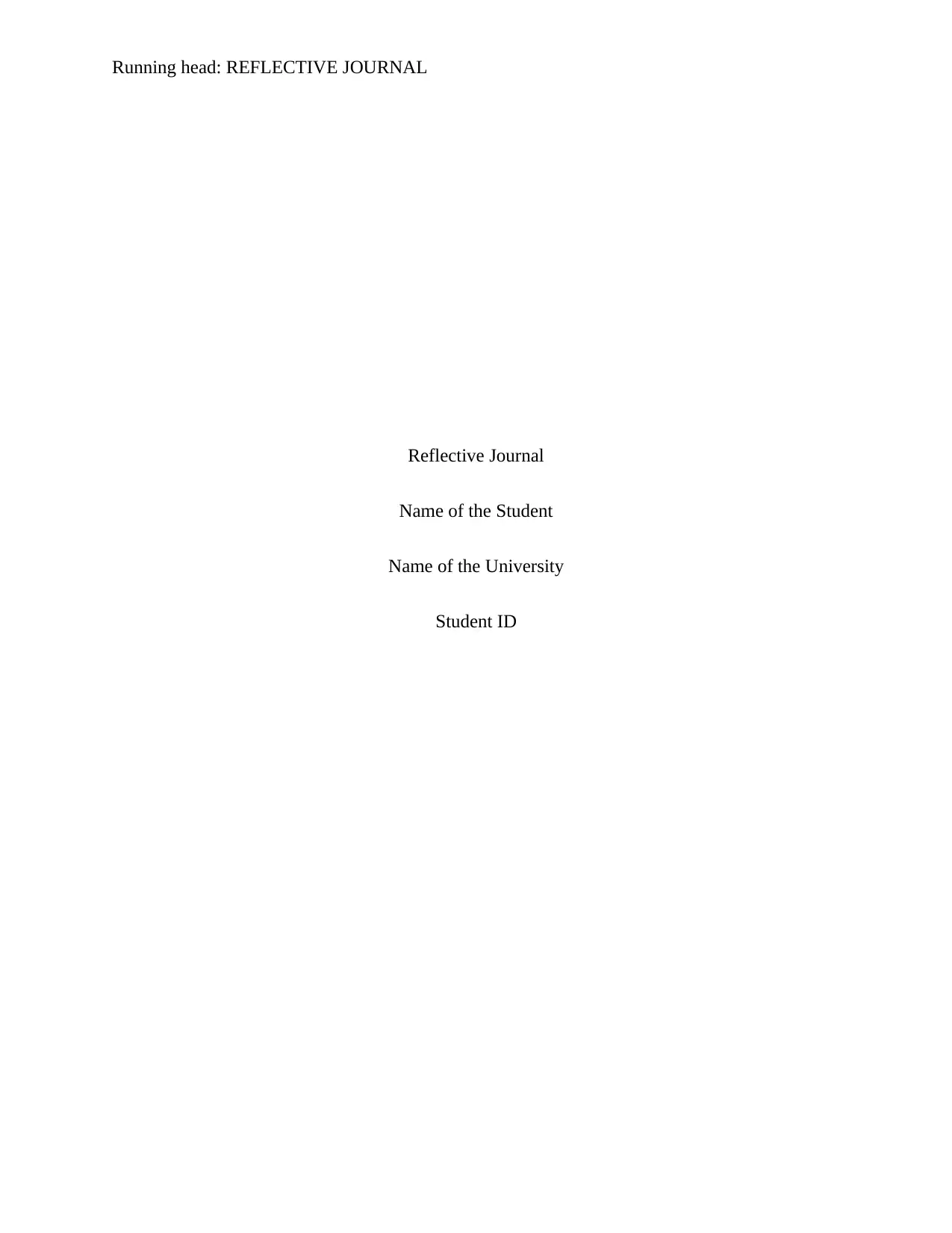
Running head: REFLECTIVE JOURNAL
Reflective Journal
Name of the Student
Name of the University
Student ID
Reflective Journal
Name of the Student
Name of the University
Student ID
Secure Best Marks with AI Grader
Need help grading? Try our AI Grader for instant feedback on your assignments.
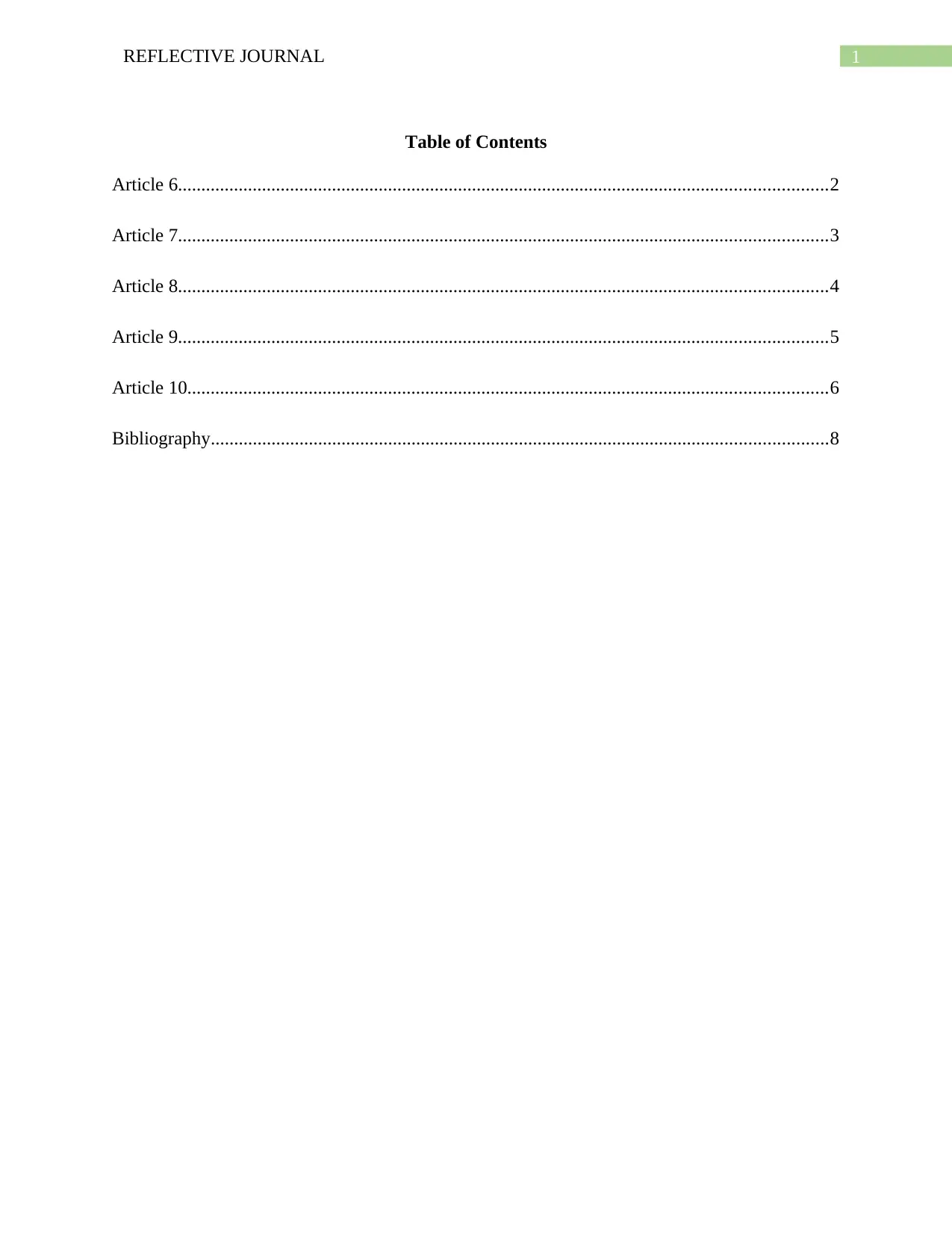
1REFLECTIVE JOURNAL
Table of Contents
Article 6...........................................................................................................................................2
Article 7...........................................................................................................................................3
Article 8...........................................................................................................................................4
Article 9...........................................................................................................................................5
Article 10.........................................................................................................................................6
Bibliography....................................................................................................................................8
Table of Contents
Article 6...........................................................................................................................................2
Article 7...........................................................................................................................................3
Article 8...........................................................................................................................................4
Article 9...........................................................................................................................................5
Article 10.........................................................................................................................................6
Bibliography....................................................................................................................................8
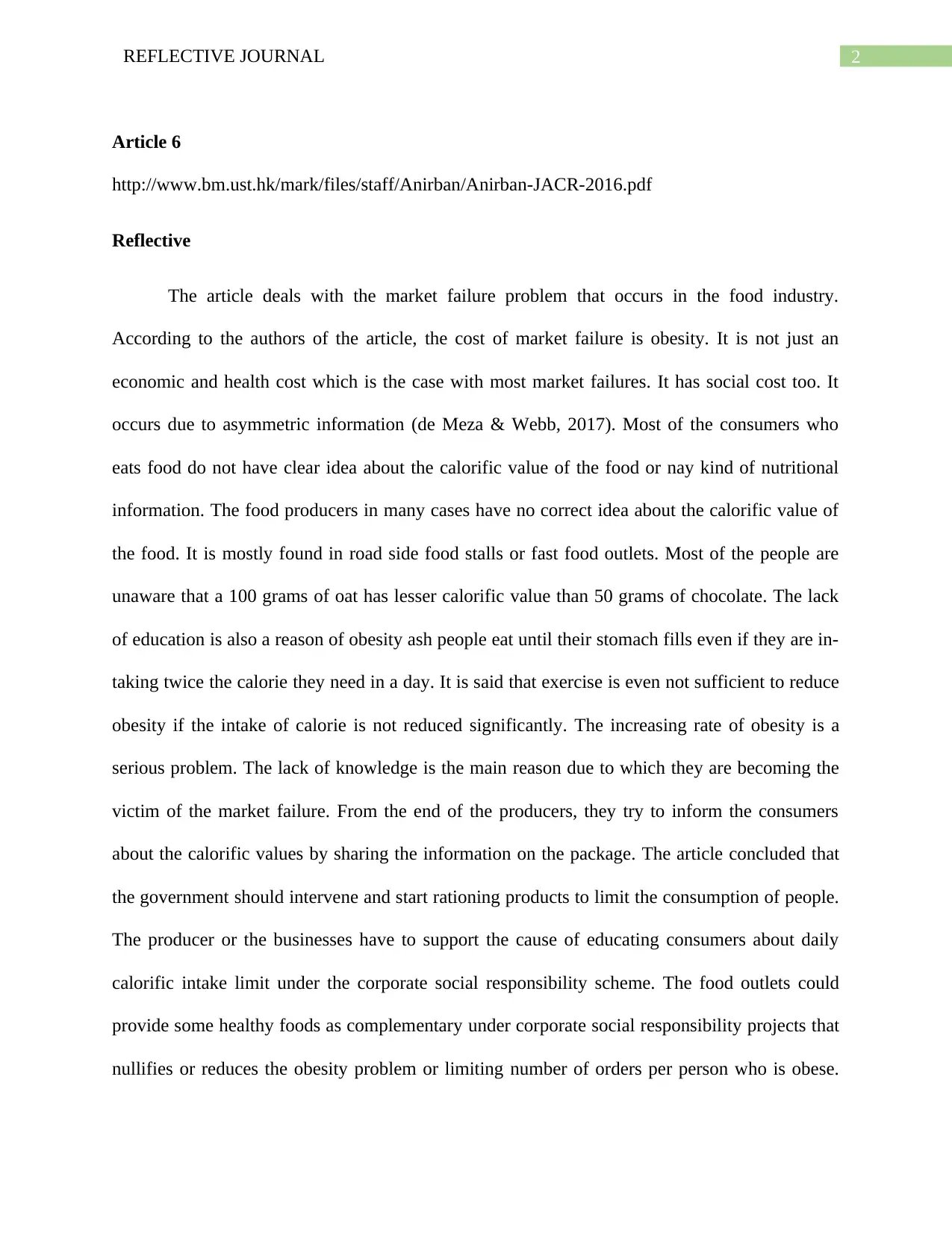
2REFLECTIVE JOURNAL
Article 6
http://www.bm.ust.hk/mark/files/staff/Anirban/Anirban-JACR-2016.pdf
Reflective
The article deals with the market failure problem that occurs in the food industry.
According to the authors of the article, the cost of market failure is obesity. It is not just an
economic and health cost which is the case with most market failures. It has social cost too. It
occurs due to asymmetric information (de Meza & Webb, 2017). Most of the consumers who
eats food do not have clear idea about the calorific value of the food or nay kind of nutritional
information. The food producers in many cases have no correct idea about the calorific value of
the food. It is mostly found in road side food stalls or fast food outlets. Most of the people are
unaware that a 100 grams of oat has lesser calorific value than 50 grams of chocolate. The lack
of education is also a reason of obesity ash people eat until their stomach fills even if they are in-
taking twice the calorie they need in a day. It is said that exercise is even not sufficient to reduce
obesity if the intake of calorie is not reduced significantly. The increasing rate of obesity is a
serious problem. The lack of knowledge is the main reason due to which they are becoming the
victim of the market failure. From the end of the producers, they try to inform the consumers
about the calorific values by sharing the information on the package. The article concluded that
the government should intervene and start rationing products to limit the consumption of people.
The producer or the businesses have to support the cause of educating consumers about daily
calorific intake limit under the corporate social responsibility scheme. The food outlets could
provide some healthy foods as complementary under corporate social responsibility projects that
nullifies or reduces the obesity problem or limiting number of orders per person who is obese.
Article 6
http://www.bm.ust.hk/mark/files/staff/Anirban/Anirban-JACR-2016.pdf
Reflective
The article deals with the market failure problem that occurs in the food industry.
According to the authors of the article, the cost of market failure is obesity. It is not just an
economic and health cost which is the case with most market failures. It has social cost too. It
occurs due to asymmetric information (de Meza & Webb, 2017). Most of the consumers who
eats food do not have clear idea about the calorific value of the food or nay kind of nutritional
information. The food producers in many cases have no correct idea about the calorific value of
the food. It is mostly found in road side food stalls or fast food outlets. Most of the people are
unaware that a 100 grams of oat has lesser calorific value than 50 grams of chocolate. The lack
of education is also a reason of obesity ash people eat until their stomach fills even if they are in-
taking twice the calorie they need in a day. It is said that exercise is even not sufficient to reduce
obesity if the intake of calorie is not reduced significantly. The increasing rate of obesity is a
serious problem. The lack of knowledge is the main reason due to which they are becoming the
victim of the market failure. From the end of the producers, they try to inform the consumers
about the calorific values by sharing the information on the package. The article concluded that
the government should intervene and start rationing products to limit the consumption of people.
The producer or the businesses have to support the cause of educating consumers about daily
calorific intake limit under the corporate social responsibility scheme. The food outlets could
provide some healthy foods as complementary under corporate social responsibility projects that
nullifies or reduces the obesity problem or limiting number of orders per person who is obese.
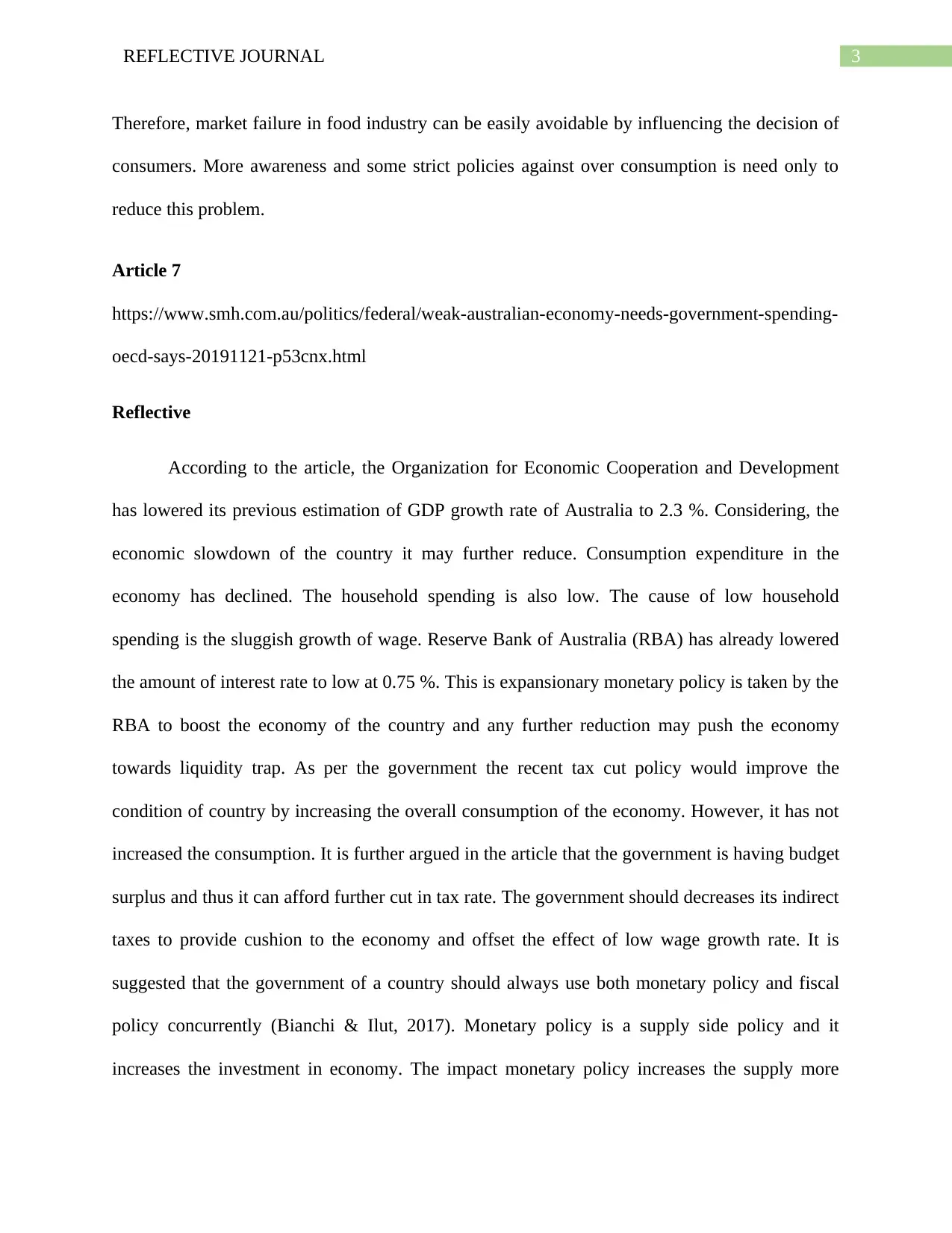
3REFLECTIVE JOURNAL
Therefore, market failure in food industry can be easily avoidable by influencing the decision of
consumers. More awareness and some strict policies against over consumption is need only to
reduce this problem.
Article 7
https://www.smh.com.au/politics/federal/weak-australian-economy-needs-government-spending-
oecd-says-20191121-p53cnx.html
Reflective
According to the article, the Organization for Economic Cooperation and Development
has lowered its previous estimation of GDP growth rate of Australia to 2.3 %. Considering, the
economic slowdown of the country it may further reduce. Consumption expenditure in the
economy has declined. The household spending is also low. The cause of low household
spending is the sluggish growth of wage. Reserve Bank of Australia (RBA) has already lowered
the amount of interest rate to low at 0.75 %. This is expansionary monetary policy is taken by the
RBA to boost the economy of the country and any further reduction may push the economy
towards liquidity trap. As per the government the recent tax cut policy would improve the
condition of country by increasing the overall consumption of the economy. However, it has not
increased the consumption. It is further argued in the article that the government is having budget
surplus and thus it can afford further cut in tax rate. The government should decreases its indirect
taxes to provide cushion to the economy and offset the effect of low wage growth rate. It is
suggested that the government of a country should always use both monetary policy and fiscal
policy concurrently (Bianchi & Ilut, 2017). Monetary policy is a supply side policy and it
increases the investment in economy. The impact monetary policy increases the supply more
Therefore, market failure in food industry can be easily avoidable by influencing the decision of
consumers. More awareness and some strict policies against over consumption is need only to
reduce this problem.
Article 7
https://www.smh.com.au/politics/federal/weak-australian-economy-needs-government-spending-
oecd-says-20191121-p53cnx.html
Reflective
According to the article, the Organization for Economic Cooperation and Development
has lowered its previous estimation of GDP growth rate of Australia to 2.3 %. Considering, the
economic slowdown of the country it may further reduce. Consumption expenditure in the
economy has declined. The household spending is also low. The cause of low household
spending is the sluggish growth of wage. Reserve Bank of Australia (RBA) has already lowered
the amount of interest rate to low at 0.75 %. This is expansionary monetary policy is taken by the
RBA to boost the economy of the country and any further reduction may push the economy
towards liquidity trap. As per the government the recent tax cut policy would improve the
condition of country by increasing the overall consumption of the economy. However, it has not
increased the consumption. It is further argued in the article that the government is having budget
surplus and thus it can afford further cut in tax rate. The government should decreases its indirect
taxes to provide cushion to the economy and offset the effect of low wage growth rate. It is
suggested that the government of a country should always use both monetary policy and fiscal
policy concurrently (Bianchi & Ilut, 2017). Monetary policy is a supply side policy and it
increases the investment in economy. The impact monetary policy increases the supply more
Secure Best Marks with AI Grader
Need help grading? Try our AI Grader for instant feedback on your assignments.
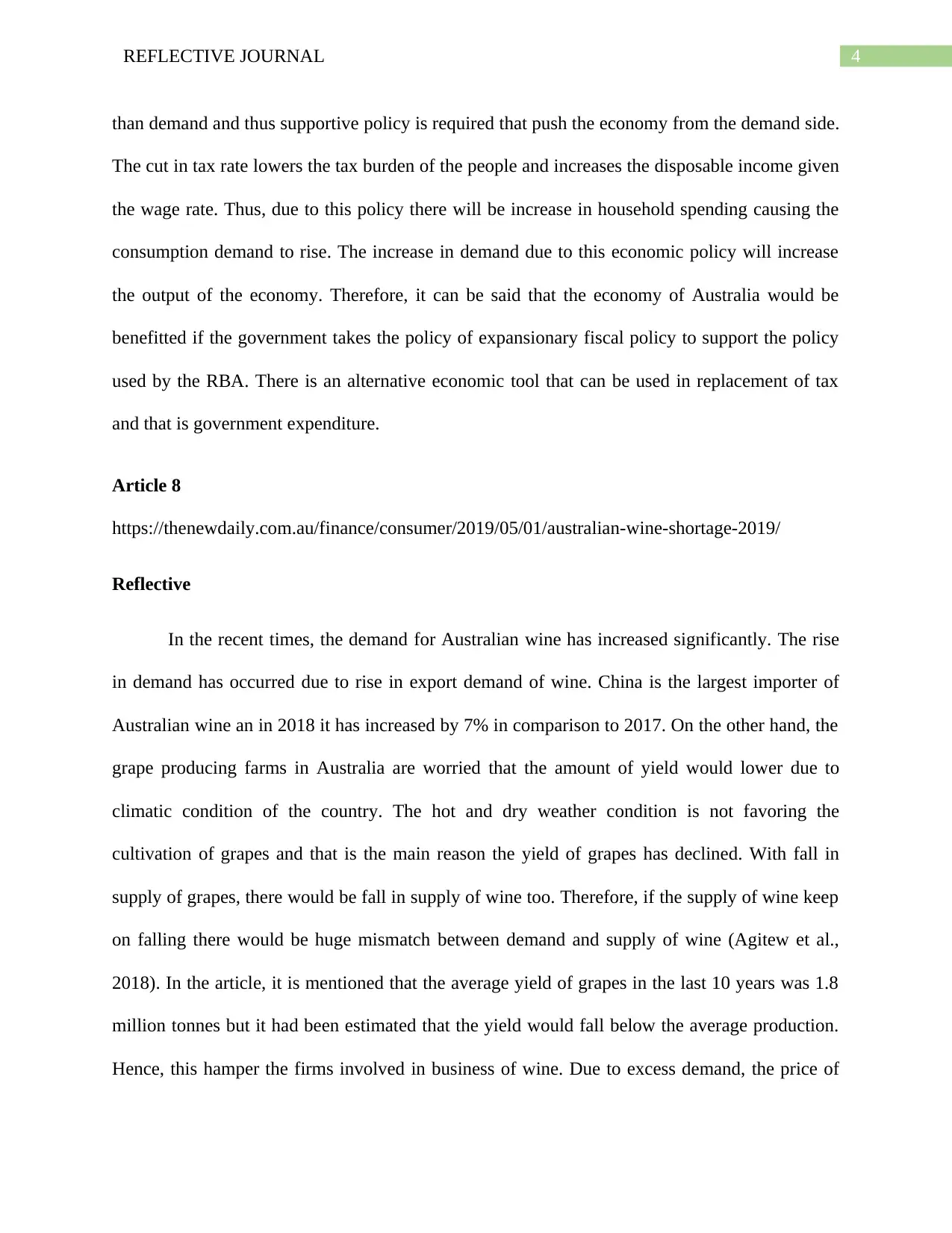
4REFLECTIVE JOURNAL
than demand and thus supportive policy is required that push the economy from the demand side.
The cut in tax rate lowers the tax burden of the people and increases the disposable income given
the wage rate. Thus, due to this policy there will be increase in household spending causing the
consumption demand to rise. The increase in demand due to this economic policy will increase
the output of the economy. Therefore, it can be said that the economy of Australia would be
benefitted if the government takes the policy of expansionary fiscal policy to support the policy
used by the RBA. There is an alternative economic tool that can be used in replacement of tax
and that is government expenditure.
Article 8
https://thenewdaily.com.au/finance/consumer/2019/05/01/australian-wine-shortage-2019/
Reflective
In the recent times, the demand for Australian wine has increased significantly. The rise
in demand has occurred due to rise in export demand of wine. China is the largest importer of
Australian wine an in 2018 it has increased by 7% in comparison to 2017. On the other hand, the
grape producing farms in Australia are worried that the amount of yield would lower due to
climatic condition of the country. The hot and dry weather condition is not favoring the
cultivation of grapes and that is the main reason the yield of grapes has declined. With fall in
supply of grapes, there would be fall in supply of wine too. Therefore, if the supply of wine keep
on falling there would be huge mismatch between demand and supply of wine (Agitew et al.,
2018). In the article, it is mentioned that the average yield of grapes in the last 10 years was 1.8
million tonnes but it had been estimated that the yield would fall below the average production.
Hence, this hamper the firms involved in business of wine. Due to excess demand, the price of
than demand and thus supportive policy is required that push the economy from the demand side.
The cut in tax rate lowers the tax burden of the people and increases the disposable income given
the wage rate. Thus, due to this policy there will be increase in household spending causing the
consumption demand to rise. The increase in demand due to this economic policy will increase
the output of the economy. Therefore, it can be said that the economy of Australia would be
benefitted if the government takes the policy of expansionary fiscal policy to support the policy
used by the RBA. There is an alternative economic tool that can be used in replacement of tax
and that is government expenditure.
Article 8
https://thenewdaily.com.au/finance/consumer/2019/05/01/australian-wine-shortage-2019/
Reflective
In the recent times, the demand for Australian wine has increased significantly. The rise
in demand has occurred due to rise in export demand of wine. China is the largest importer of
Australian wine an in 2018 it has increased by 7% in comparison to 2017. On the other hand, the
grape producing farms in Australia are worried that the amount of yield would lower due to
climatic condition of the country. The hot and dry weather condition is not favoring the
cultivation of grapes and that is the main reason the yield of grapes has declined. With fall in
supply of grapes, there would be fall in supply of wine too. Therefore, if the supply of wine keep
on falling there would be huge mismatch between demand and supply of wine (Agitew et al.,
2018). In the article, it is mentioned that the average yield of grapes in the last 10 years was 1.8
million tonnes but it had been estimated that the yield would fall below the average production.
Hence, this hamper the firms involved in business of wine. Due to excess demand, the price of
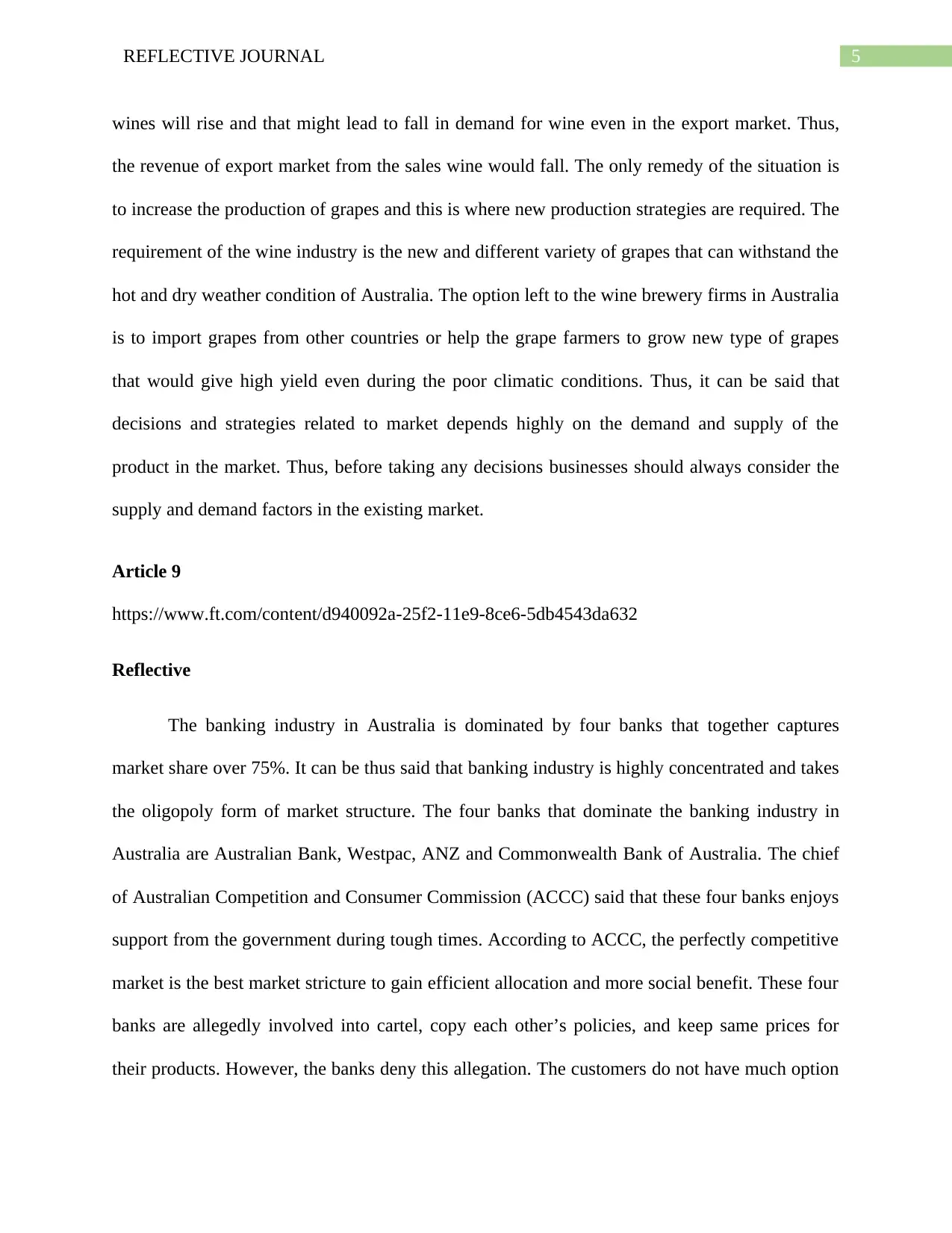
5REFLECTIVE JOURNAL
wines will rise and that might lead to fall in demand for wine even in the export market. Thus,
the revenue of export market from the sales wine would fall. The only remedy of the situation is
to increase the production of grapes and this is where new production strategies are required. The
requirement of the wine industry is the new and different variety of grapes that can withstand the
hot and dry weather condition of Australia. The option left to the wine brewery firms in Australia
is to import grapes from other countries or help the grape farmers to grow new type of grapes
that would give high yield even during the poor climatic conditions. Thus, it can be said that
decisions and strategies related to market depends highly on the demand and supply of the
product in the market. Thus, before taking any decisions businesses should always consider the
supply and demand factors in the existing market.
Article 9
https://www.ft.com/content/d940092a-25f2-11e9-8ce6-5db4543da632
Reflective
The banking industry in Australia is dominated by four banks that together captures
market share over 75%. It can be thus said that banking industry is highly concentrated and takes
the oligopoly form of market structure. The four banks that dominate the banking industry in
Australia are Australian Bank, Westpac, ANZ and Commonwealth Bank of Australia. The chief
of Australian Competition and Consumer Commission (ACCC) said that these four banks enjoys
support from the government during tough times. According to ACCC, the perfectly competitive
market is the best market stricture to gain efficient allocation and more social benefit. These four
banks are allegedly involved into cartel, copy each other’s policies, and keep same prices for
their products. However, the banks deny this allegation. The customers do not have much option
wines will rise and that might lead to fall in demand for wine even in the export market. Thus,
the revenue of export market from the sales wine would fall. The only remedy of the situation is
to increase the production of grapes and this is where new production strategies are required. The
requirement of the wine industry is the new and different variety of grapes that can withstand the
hot and dry weather condition of Australia. The option left to the wine brewery firms in Australia
is to import grapes from other countries or help the grape farmers to grow new type of grapes
that would give high yield even during the poor climatic conditions. Thus, it can be said that
decisions and strategies related to market depends highly on the demand and supply of the
product in the market. Thus, before taking any decisions businesses should always consider the
supply and demand factors in the existing market.
Article 9
https://www.ft.com/content/d940092a-25f2-11e9-8ce6-5db4543da632
Reflective
The banking industry in Australia is dominated by four banks that together captures
market share over 75%. It can be thus said that banking industry is highly concentrated and takes
the oligopoly form of market structure. The four banks that dominate the banking industry in
Australia are Australian Bank, Westpac, ANZ and Commonwealth Bank of Australia. The chief
of Australian Competition and Consumer Commission (ACCC) said that these four banks enjoys
support from the government during tough times. According to ACCC, the perfectly competitive
market is the best market stricture to gain efficient allocation and more social benefit. These four
banks are allegedly involved into cartel, copy each other’s policies, and keep same prices for
their products. However, the banks deny this allegation. The customers do not have much option
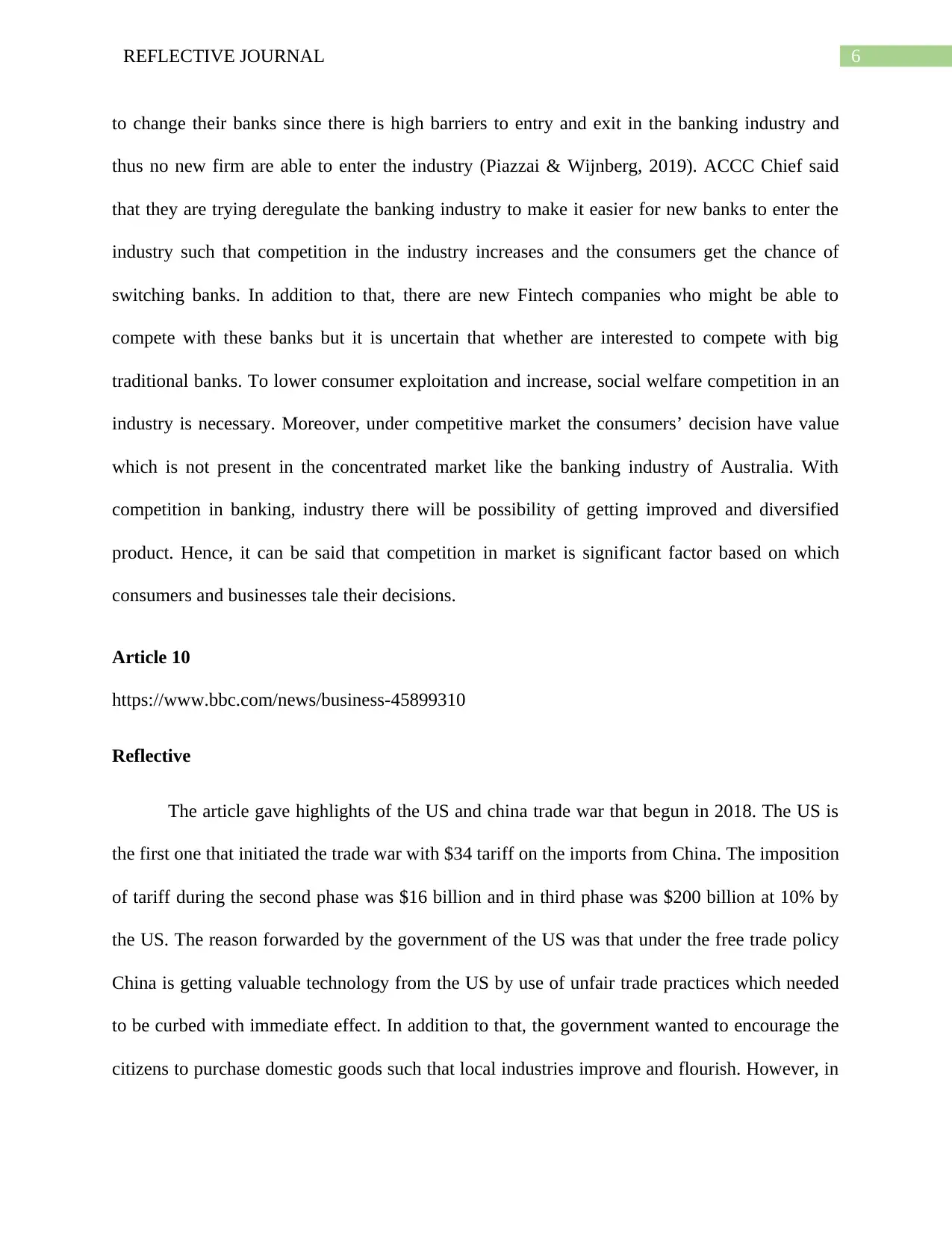
6REFLECTIVE JOURNAL
to change their banks since there is high barriers to entry and exit in the banking industry and
thus no new firm are able to enter the industry (Piazzai & Wijnberg, 2019). ACCC Chief said
that they are trying deregulate the banking industry to make it easier for new banks to enter the
industry such that competition in the industry increases and the consumers get the chance of
switching banks. In addition to that, there are new Fintech companies who might be able to
compete with these banks but it is uncertain that whether are interested to compete with big
traditional banks. To lower consumer exploitation and increase, social welfare competition in an
industry is necessary. Moreover, under competitive market the consumers’ decision have value
which is not present in the concentrated market like the banking industry of Australia. With
competition in banking, industry there will be possibility of getting improved and diversified
product. Hence, it can be said that competition in market is significant factor based on which
consumers and businesses tale their decisions.
Article 10
https://www.bbc.com/news/business-45899310
Reflective
The article gave highlights of the US and china trade war that begun in 2018. The US is
the first one that initiated the trade war with $34 tariff on the imports from China. The imposition
of tariff during the second phase was $16 billion and in third phase was $200 billion at 10% by
the US. The reason forwarded by the government of the US was that under the free trade policy
China is getting valuable technology from the US by use of unfair trade practices which needed
to be curbed with immediate effect. In addition to that, the government wanted to encourage the
citizens to purchase domestic goods such that local industries improve and flourish. However, in
to change their banks since there is high barriers to entry and exit in the banking industry and
thus no new firm are able to enter the industry (Piazzai & Wijnberg, 2019). ACCC Chief said
that they are trying deregulate the banking industry to make it easier for new banks to enter the
industry such that competition in the industry increases and the consumers get the chance of
switching banks. In addition to that, there are new Fintech companies who might be able to
compete with these banks but it is uncertain that whether are interested to compete with big
traditional banks. To lower consumer exploitation and increase, social welfare competition in an
industry is necessary. Moreover, under competitive market the consumers’ decision have value
which is not present in the concentrated market like the banking industry of Australia. With
competition in banking, industry there will be possibility of getting improved and diversified
product. Hence, it can be said that competition in market is significant factor based on which
consumers and businesses tale their decisions.
Article 10
https://www.bbc.com/news/business-45899310
Reflective
The article gave highlights of the US and china trade war that begun in 2018. The US is
the first one that initiated the trade war with $34 tariff on the imports from China. The imposition
of tariff during the second phase was $16 billion and in third phase was $200 billion at 10% by
the US. The reason forwarded by the government of the US was that under the free trade policy
China is getting valuable technology from the US by use of unfair trade practices which needed
to be curbed with immediate effect. In addition to that, the government wanted to encourage the
citizens to purchase domestic goods such that local industries improve and flourish. However, in
Paraphrase This Document
Need a fresh take? Get an instant paraphrase of this document with our AI Paraphraser
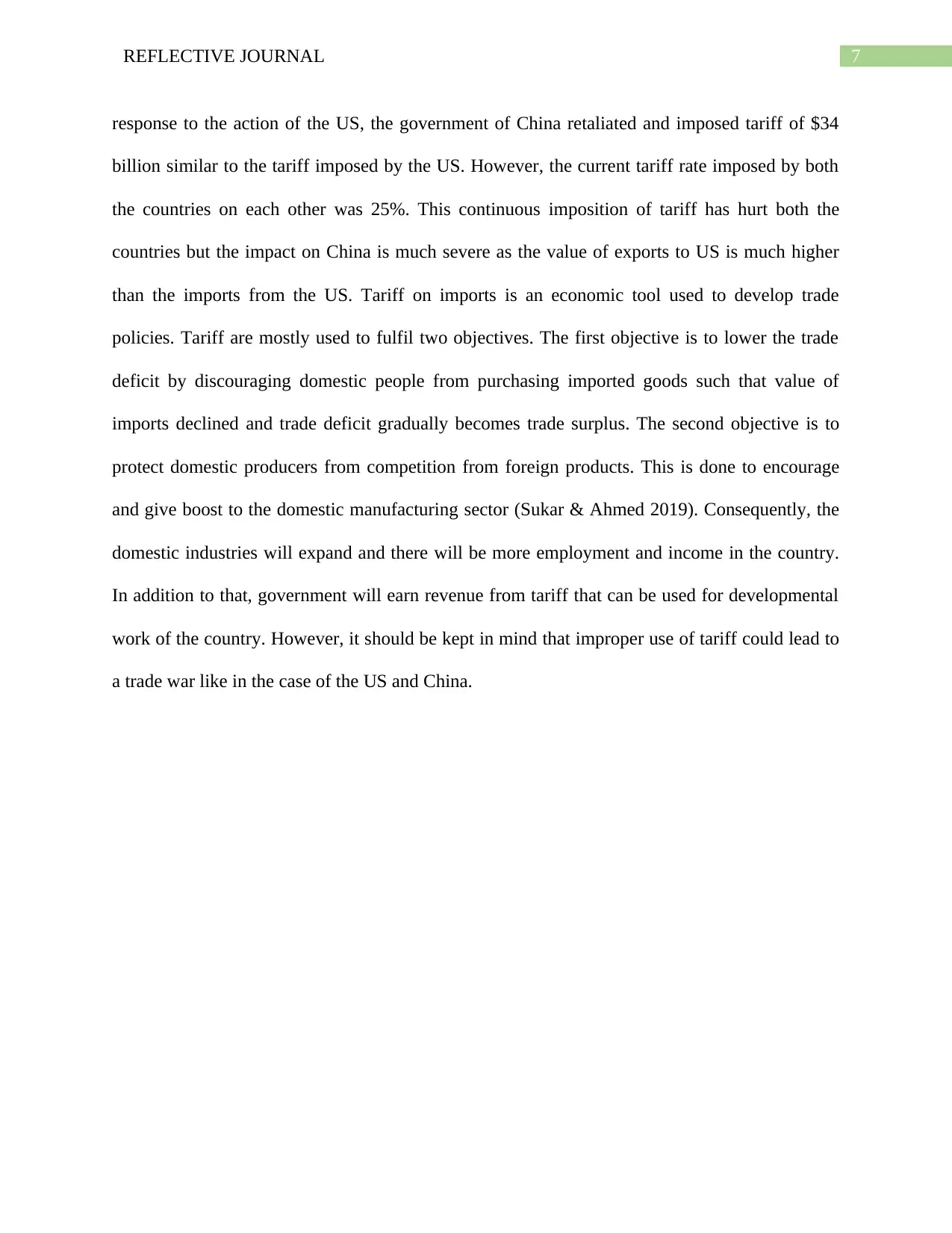
7REFLECTIVE JOURNAL
response to the action of the US, the government of China retaliated and imposed tariff of $34
billion similar to the tariff imposed by the US. However, the current tariff rate imposed by both
the countries on each other was 25%. This continuous imposition of tariff has hurt both the
countries but the impact on China is much severe as the value of exports to US is much higher
than the imports from the US. Tariff on imports is an economic tool used to develop trade
policies. Tariff are mostly used to fulfil two objectives. The first objective is to lower the trade
deficit by discouraging domestic people from purchasing imported goods such that value of
imports declined and trade deficit gradually becomes trade surplus. The second objective is to
protect domestic producers from competition from foreign products. This is done to encourage
and give boost to the domestic manufacturing sector (Sukar & Ahmed 2019). Consequently, the
domestic industries will expand and there will be more employment and income in the country.
In addition to that, government will earn revenue from tariff that can be used for developmental
work of the country. However, it should be kept in mind that improper use of tariff could lead to
a trade war like in the case of the US and China.
response to the action of the US, the government of China retaliated and imposed tariff of $34
billion similar to the tariff imposed by the US. However, the current tariff rate imposed by both
the countries on each other was 25%. This continuous imposition of tariff has hurt both the
countries but the impact on China is much severe as the value of exports to US is much higher
than the imports from the US. Tariff on imports is an economic tool used to develop trade
policies. Tariff are mostly used to fulfil two objectives. The first objective is to lower the trade
deficit by discouraging domestic people from purchasing imported goods such that value of
imports declined and trade deficit gradually becomes trade surplus. The second objective is to
protect domestic producers from competition from foreign products. This is done to encourage
and give boost to the domestic manufacturing sector (Sukar & Ahmed 2019). Consequently, the
domestic industries will expand and there will be more employment and income in the country.
In addition to that, government will earn revenue from tariff that can be used for developmental
work of the country. However, it should be kept in mind that improper use of tariff could lead to
a trade war like in the case of the US and China.
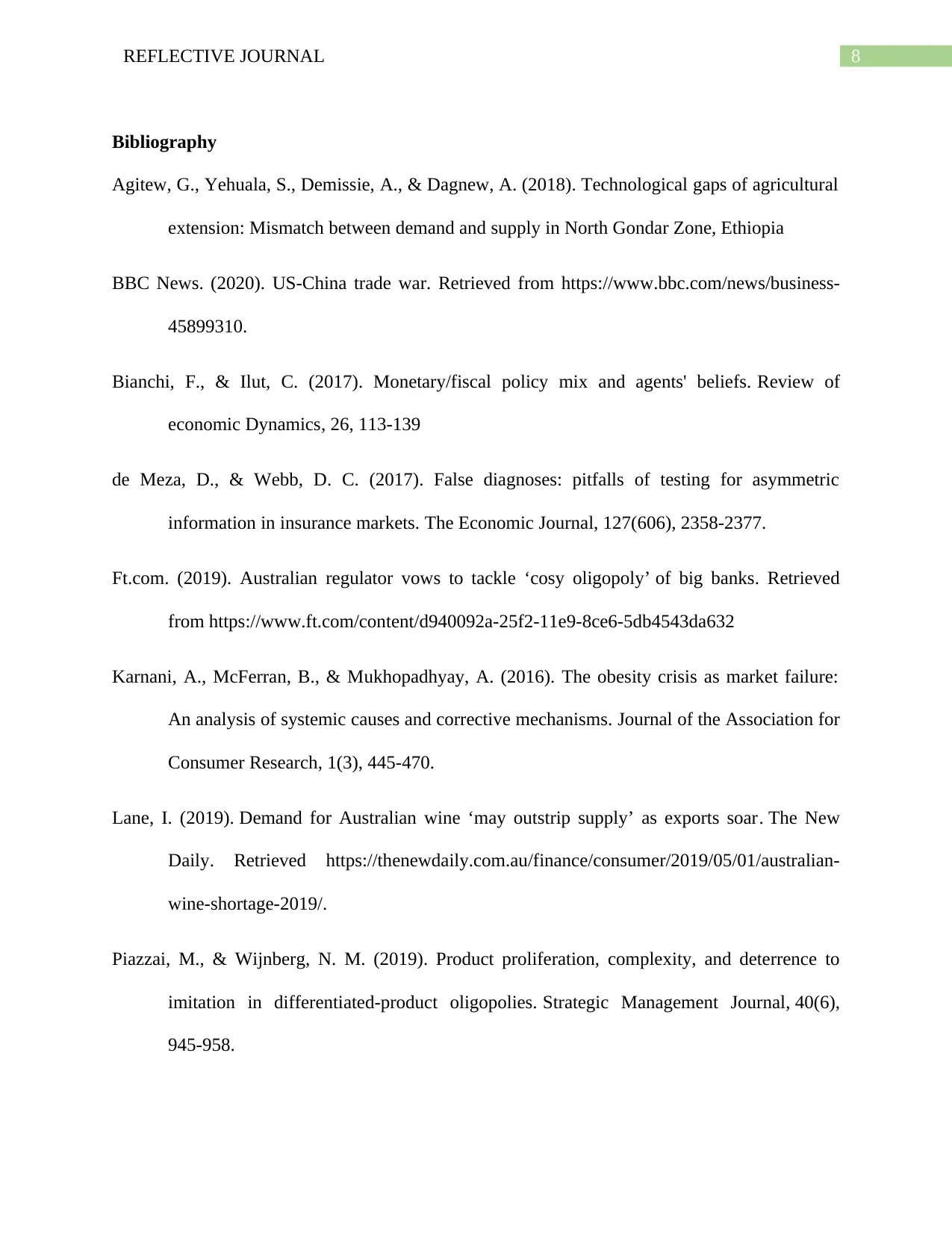
8REFLECTIVE JOURNAL
Bibliography
Agitew, G., Yehuala, S., Demissie, A., & Dagnew, A. (2018). Technological gaps of agricultural
extension: Mismatch between demand and supply in North Gondar Zone, Ethiopia
BBC News. (2020). US-China trade war. Retrieved from https://www.bbc.com/news/business-
45899310.
Bianchi, F., & Ilut, C. (2017). Monetary/fiscal policy mix and agents' beliefs. Review of
economic Dynamics, 26, 113-139
de Meza, D., & Webb, D. C. (2017). False diagnoses: pitfalls of testing for asymmetric
information in insurance markets. The Economic Journal, 127(606), 2358-2377.
Ft.com. (2019). Australian regulator vows to tackle ‘cosy oligopoly’ of big banks. Retrieved
from https://www.ft.com/content/d940092a-25f2-11e9-8ce6-5db4543da632
Karnani, A., McFerran, B., & Mukhopadhyay, A. (2016). The obesity crisis as market failure:
An analysis of systemic causes and corrective mechanisms. Journal of the Association for
Consumer Research, 1(3), 445-470.
Lane, I. (2019). Demand for Australian wine ‘may outstrip supply’ as exports soar. The New
Daily. Retrieved https://thenewdaily.com.au/finance/consumer/2019/05/01/australian-
wine-shortage-2019/.
Piazzai, M., & Wijnberg, N. M. (2019). Product proliferation, complexity, and deterrence to
imitation in differentiated‐product oligopolies. Strategic Management Journal, 40(6),
945-958.
Bibliography
Agitew, G., Yehuala, S., Demissie, A., & Dagnew, A. (2018). Technological gaps of agricultural
extension: Mismatch between demand and supply in North Gondar Zone, Ethiopia
BBC News. (2020). US-China trade war. Retrieved from https://www.bbc.com/news/business-
45899310.
Bianchi, F., & Ilut, C. (2017). Monetary/fiscal policy mix and agents' beliefs. Review of
economic Dynamics, 26, 113-139
de Meza, D., & Webb, D. C. (2017). False diagnoses: pitfalls of testing for asymmetric
information in insurance markets. The Economic Journal, 127(606), 2358-2377.
Ft.com. (2019). Australian regulator vows to tackle ‘cosy oligopoly’ of big banks. Retrieved
from https://www.ft.com/content/d940092a-25f2-11e9-8ce6-5db4543da632
Karnani, A., McFerran, B., & Mukhopadhyay, A. (2016). The obesity crisis as market failure:
An analysis of systemic causes and corrective mechanisms. Journal of the Association for
Consumer Research, 1(3), 445-470.
Lane, I. (2019). Demand for Australian wine ‘may outstrip supply’ as exports soar. The New
Daily. Retrieved https://thenewdaily.com.au/finance/consumer/2019/05/01/australian-
wine-shortage-2019/.
Piazzai, M., & Wijnberg, N. M. (2019). Product proliferation, complexity, and deterrence to
imitation in differentiated‐product oligopolies. Strategic Management Journal, 40(6),
945-958.
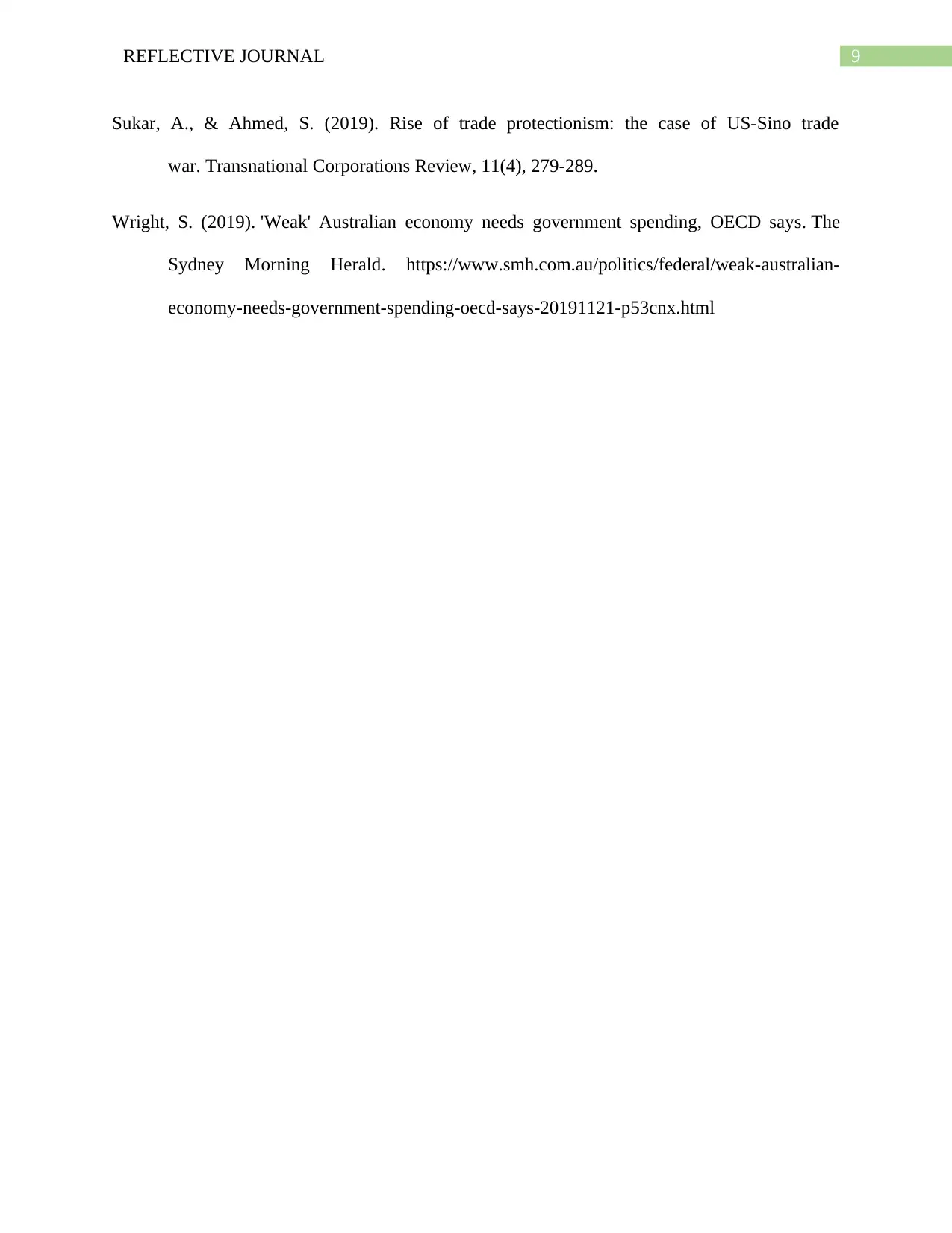
9REFLECTIVE JOURNAL
Sukar, A., & Ahmed, S. (2019). Rise of trade protectionism: the case of US-Sino trade
war. Transnational Corporations Review, 11(4), 279-289.
Wright, S. (2019). 'Weak' Australian economy needs government spending, OECD says. The
Sydney Morning Herald. https://www.smh.com.au/politics/federal/weak-australian-
economy-needs-government-spending-oecd-says-20191121-p53cnx.html
Sukar, A., & Ahmed, S. (2019). Rise of trade protectionism: the case of US-Sino trade
war. Transnational Corporations Review, 11(4), 279-289.
Wright, S. (2019). 'Weak' Australian economy needs government spending, OECD says. The
Sydney Morning Herald. https://www.smh.com.au/politics/federal/weak-australian-
economy-needs-government-spending-oecd-says-20191121-p53cnx.html
1 out of 10
Related Documents
Your All-in-One AI-Powered Toolkit for Academic Success.
+13062052269
info@desklib.com
Available 24*7 on WhatsApp / Email
![[object Object]](/_next/static/media/star-bottom.7253800d.svg)
Unlock your academic potential
© 2024 | Zucol Services PVT LTD | All rights reserved.




